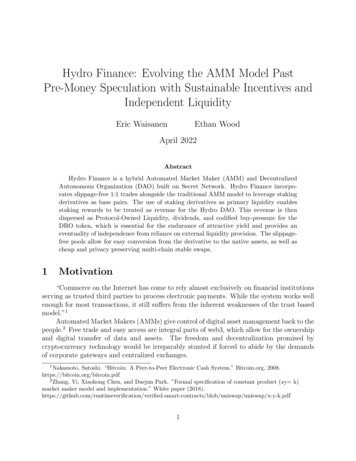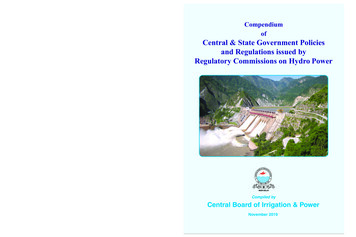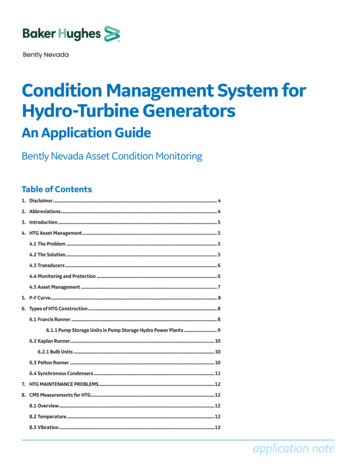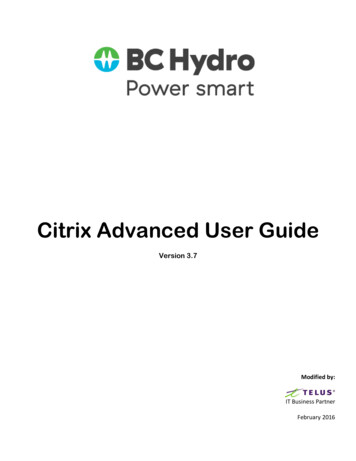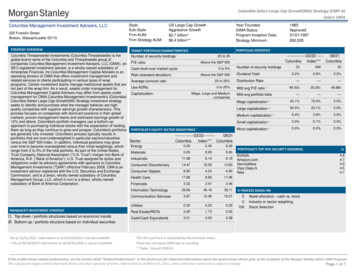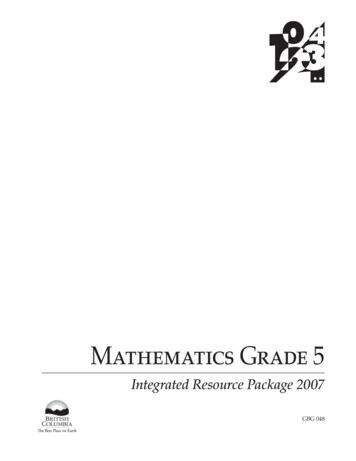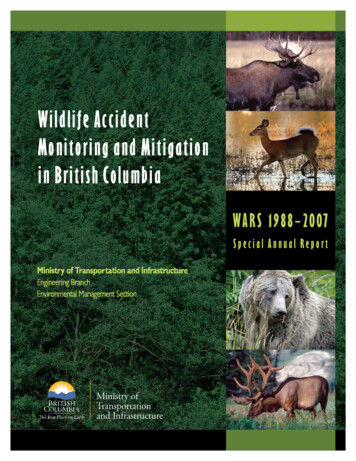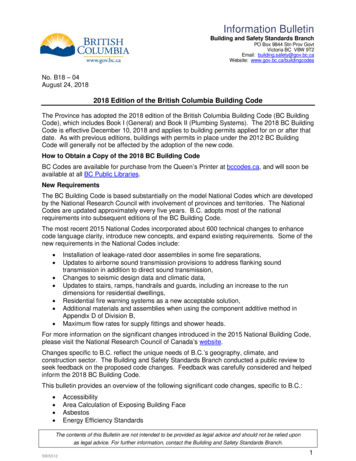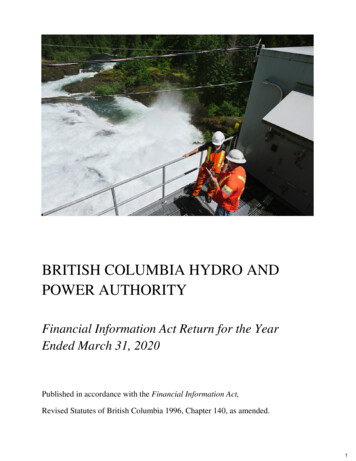
Transcription
BRITISH COLUMBIA HYDRO ANDPOWER AUTHORITYFinancial Information Act Return for the YearEnded March 31, 2020Published in accordance with the Financial Information Act,Revised Statutes of British Columbia 1996, Chapter 140, as amended.1
FINANCIAL INFORMATION ACT RETURN FOR THE YEAR ENDED MARCH 31, 2020TABLE OF CONTENTSStatement of Financial Information Approval3Audited Consolidated Financial Statements Fiscal 20204British Columbia Hydro and Power Authority and its subsidiary Powerex Corp.Schedule of Remuneration and Expenses – Board of Directors73British Columbia Hydro and Power AuthoritySchedule of DebtsSchedule of Guarantee and Indemnity AgreementsSchedule of Remuneration and ExpensesSchedule of Payments to Suppliers for Goods and ServicesStatement of Grants and Contributions757677154191Powerex Corp.Schedule of Remuneration and ExpensesSchedule of Payments to Suppliers for Goods and Services192196Powertech Labs Inc.Schedule of Remuneration and ExpensesSchedule of Payments to Suppliers for Goods and Services2002042
BRITISH COLUMBA HYDRO AND POWER AUTHORITYSTATEMENT OF FINANCIAL INFORMATION APPROVALThe undersigned represents the Board of Directors of the British Columbia Hydro and PowerAuthority and approves the information contained in the Statement and Schedules of FinancialInformation prepared in accordance with the Financial Information Act.Kenneth G. PetersonChair of the Board3
British Columbia Hydro and Power AuthorityManagement ReportThe consolidated financial statements of British Columbia Hydro and Power Authority (BC Hydro) are theresponsibility of management and have been prepared in accordance with International Financial ReportingStandards. The preparation of financial statements necessarily involves the use of estimates which havebeen made using careful judgment. In management’s opinion, the consolidated financial statements havebeen properly prepared within the framework of the accounting policies summarized in the consolidatedfinancial statements and incorporate, within reasonable limits of materiality, all information available atJune 4, 2020. The consolidated financial statements have also been reviewed by the Audit & FinanceCommittee and approved by the Board of Directors. Financial information presented elsewhere in thisAnnual Service Plan Report is consistent with that in the consolidated financial statements.Management maintains systems of internal controls designed to provide reasonable assurance that assetsare safeguarded and that reliable financial information is available on a timely basis. These systems includeformal written policies and procedures, careful selection and training of qualified personnel andappropriate delegation of authority and segregation of responsibilities within the organization. An internalaudit function independently evaluates the effectiveness of these internal controls on an ongoing basis andreports its findings to management and the Audit & Finance Committee.The consolidated financial statements have been examined by independent external auditors. The externalauditors’ responsibility is to express their opinion on whether the consolidated financial statements, in allmaterial respects, fairly present BC Hydro’s financial position, comprehensive income and cash flows inaccordance with International Financial Reporting Standards. The Independent Auditors’ Report, whichfollows, outlines the scope of their examination and their opinion.The Board of Directors, through the Audit & Finance Committee, is responsible for ensuring thatmanagement fulfills its responsibility for financial reporting and internal controls. The Audit & FinanceCommittee, comprised of directors who are not employees, meets regularly with the external auditors, theinternal auditors and management to satisfy itself that each group has properly discharged its responsibilityto review the financial statements before recommending approval by the Board of Directors. The internaland external auditors have full and open access to the Audit & Finance Committee, with and without thepresence of management.Chris O’RileyPresident and Chief Executive OfficerDavid WongExecutive Vice President, Finance, Technology,Supply Chain and Chief Financial OfficerVancouver, CanadaJune 4, 20204
INDEPENDENT AUDITOR'S REPORTTo the Board of Directors of the British Columbia Hydro and Power Authority, andTo the Minister of Energy, Mines and Petroleum Resources, Province of British ColumbiaOpinionI have audited the accompanying consolidated financial statements of the British ColumbiaHydro and Power Authority (“the group”), which comprise the consolidated statement offinancial position at March 31, 2020, and the consolidated statements of comprehensive income(loss), changes in equity and cash flows for the year then ended, and a summary of significantaccounting policies and other explanatory information.In my opinion, the accompanying consolidated financial statements present fairly, in all materialrespects, the financial position of the group as at March 31, 2020, and its financial performanceand its cash flows for the year then ended in accordance with International Financial ReportingStandards (IFRS).Basis for OpinionI conducted my audit in accordance with Canadian generally accepted auditing standards. Myresponsibilities under those standards are further described in the Auditor's Responsibilities forthe Audit of the Consolidated Financial Statements section of my report. I am independent of thegroup in accordance with the ethical requirements that are relevant to my audit of theconsolidated financial statements in Canada, and I have fulfilled my other ethical responsibilitiesin accordance with these requirements. I believe that the audit evidence I have obtained issufficient and appropriate to provide a basis for my opinion.Other MatterThe consolidated financial statements of the British Columbia Hydro and Power Authority forthe year ended March 31, 2019, were audited by another auditor who expressed an unmodifiedopinion on those statements on June 12, 2019.Other Accompanying InformationManagement is responsible for the other information. The other information comprises theinformation included in the Annual Service Plan Report but does not include the consolidatedfinancial statements and my auditor’s report thereon.My opinion on the consolidated financial statements does not cover the other informationaccompanying the financial statements and I do not express any form of assurance conclusionthereon.5
BRITISH COLUMBIA HYDRO AND POWER AUTHORITYIndependent Auditor’s ReportIn connection with my audit of the consolidated financial statements, my responsibility is to readthe other information that I have obtained prior to the date of my auditor’s report and, in doingso, consider whether the other information is materially inconsistent with the consolidatedfinancial statements or my knowledge obtained during the audit or otherwise appears to bematerially misstated.Prior to the date of my auditor’s report, I obtained the draft 2019/20 Annual Service Plan Report.If, based on the work I have performed on this other information, I conclude that there is amaterial misstatement therein, I am required to report that fact in this auditor’s report. I havenothing to report in this regard.Responsibilities of Management and Those Charged with Governance for the ConsolidatedFinancial Statements.Those charged with governance are responsible for the oversight of the financial reportingprocess. Management is responsible for the preparation and fair presentation of the consolidatedfinancial statements in accordance with International Financial Reporting Standards (IFRS), andfor such internal control as management determines is necessary to enable the preparation of theconsolidated financial statements that are free from material misstatement, whether due to fraudor error.In preparing the consolidated financial statements, management is responsible for assessing thegroup’s ability to continue as a going concern, disclosing, as applicable, matters related to goingconcern and using the going concern basis of accounting when the group will continue itsoperations for the foreseeable future.Auditor’s Responsibilities for the Audit of Financial StatementsMy objectives are to obtain reasonable assurance about whether the group’s financial statementsas a whole are free from material misstatement, whether due to fraud or error, and to issue anauditor’s report that includes my opinion. Reasonable assurance is a high level of assurance butis not a guarantee that an audit conducted in accordance with Canadian generally acceptedauditing standards will always detect a material misstatement, when it exists. Misstatements canarise from fraud or error and are considered material if, individually or in aggregate, they couldreasonably be expected to influence the economic decision of users taken on the basis of theseconsolidated financial statements.As part of an audit in accordance with Canadian generally accepted auditing standards, I exerciseprofessional judgment and maintain professional skepticism throughout the audit. I also: Identify and assess the risks of material misstatement of the consolidated financialstatements, whether due to fraud or error, design and perform audit procedures responsiveto those risks, and obtain audit evidence that is sufficient and appropriate to provide abasis for my opinion. The risk of not detecting a material misstatement resulting from6
BRITISH COLUMBIA HYDRO AND POWER AUTHORITYIndependent Auditor’s Report fraud is higher than one resulting from error, as fraud may involve collusion, forgery,intentional omissions, misrepresentations, or the override of internal control.Obtain an understanding of internal control relevant to the audit in order to design auditprocedures that are appropriate in the circumstances, but not for the purpose ofexpressing an opinion on the effectiveness of the group’s internal control.Evaluate the appropriateness of accounting policies used and the reasonableness ofaccounting estimates and related disclosures made by management.Conclude on the appropriateness of management’s use of the going concern basis ofaccounting and, based on the audit evidence obtained, whether a material uncertaintyexists related to events or conditions that may cast significant doubt on the group’s abilityto continue as a going concern. If I conclude that a material uncertainty exists, I amrequired to draw attention in my auditor’s report to the related disclosures in theconsolidated financial statements or, if such disclosures are inadequate, to modify myopinion. My conclusions are based on the audit evidence obtained up to the date of myauditor’s report. However, future events or conditions may cause the group to cease tocontinue as a going concern.Evaluate the overall presentation, structure and content of the consolidated financialstatements, including the disclosures, and whether the consolidated financial statementsrepresent the underlying transactions and events in a manner that achieves fairpresentation.Obtain sufficient appropriate audit evidence regarding the financial information of theentities or business activities within the group to express an opinion on the consolidatedfinancial statements. I am responsible for the direction, supervision and performance ofthe group audit and I remain solely responsible for my audit opinion.I communicate with those charged with governance regarding, among other matters, the plannedscope and timing of the audit and significant audit findings, including any significantdeficiencies in internal control that I identify during my audit.I also provide those charged with governance with a statement that I have complied with relevantethical requirements regarding independence, and to communicate with them all relationshipsand other matters that may reasonably be thought to bear on my independence, and whereapplicable, related safeguards.Russ Jones, FCPA, FCA, ICD.DAuditor General (Acting)Victoria, British Columbia, CanadaJune 4, 20207
British Columbia Hydro and Power AuthorityAudited Financial StatementsConsolidated Statements of Comprehensive Income (Loss)2020for the years ended March 31 (CAD in millions)Revenues (Note 4)DomesticTrade ExpensesOperating expenses (Note 5)Finance charges (Note 6)Net Income (Loss) Before Movement in Regulatory BalancesNet movement in regulatory balances (Note 15)Net Income (Loss)5,3938766,2692019(Note 27) 2(1,120)(428)OTHER COMPREHENSIVE INCOME (LOSS)Items That Will Be Reclassified to Net Income (Loss)Effective portion of changes in fair value of derivatives designatedas cash flow hedges (Note 23)Reclassification to income (loss) of derivatives designatedas cash flow hedges (Note 23)Foreign currency translation gainsItems That Will Not Be Reclassified to Net Income (Loss)Actuarial gain (loss)Other Comprehensive Income (Loss) before movement inregulatory balancesNet movements in regulatory balances (Note 15)Other Comprehensive Income (Loss)Total Comprehensive Income (Loss) 64(24)(63)283317(173)320(317)3708(186)173(13)(441) See accompanying Notes to the Consolidated Financial Statements.8
British Columbia Hydro and Power AuthorityConsolidated Statements of Financial PositionAs atMarch 312020(CAD in millions)ASSETSCurrent AssetsCash and cash equivalents (Note 8)Restricted cash (Note 8)Accounts receivable and accrued revenue (Note 9)Inventories (Note 10)Prepaid expensesCurrent portion of derivative financial instrument assets (Note 23) Non-Current AssetsProperty, plant and equipment (Note 11)Right-of-use assets (Note 12)Intangible assets (Note 13)Derivative financial instrument assets (Note 23)Other non-current assets (Note 14)Total AssetsRegulatory Balances (Note 15)Total Assets and Regulatory Balances 5825,48639,068As atMarch 312019(Note 27) 605,00736,567As atApril 12018(Note 27) 6555,95534,610LIABILITIES AND EQUITYCurrent LiabilitiesAccounts payable and accrued liabilities (Note 16)Current portion of long-term debt (Note 17)Current portion of unearned revenues and contributions in aid (Note 20)Current portion of derivative financial instrument liabilities (Note 23) Non-Current LiabilitiesLong-term debt (Note 17)Lease liabilities (Note 19)Derivative financial instrument liabilities (Note 23)Unearned revenues and contributions in aid (Note 20)Post-employment benefits (Note 22)Other non-current liabilities (Note 24)Total LiabilitiesRegulatory Balances (Note 15)Total Liabilities and Regulatory BalancesShareholder's EquityContributed surplusRetained earningsAccumulated other comprehensive lossTotal Liabilities, Regulatory Balances, and Shareholder's Equity 1,6263,843933585,920 1,5463,12187894,843 7)4,94636,567605,420(34)5,44634,610 Commitments and Contingencies (Notes 11 and 25), and Subsequent Events (Note 28)See accompanying Notes to the Consolidated Financial Statements.Approved on behalf of the Board:Ken PetersonBoard ChairLen Boggio, FCPA, FCA, ICD.DChair, Audit & Finance Committee9
British Columbia Hydro and Power AuthorityConsolidated Statements of Changes in EquityTotalUnrealizedAccumulatedCumulative Income (Loss)OtherTranslation on Cash Flow Comprehensive ContributedReserveSurplusIncome (Loss)Hedges(CAD in millions)Balance as at April 1, 2018 Payment to the Province (Note 21)Comprehensive Income (Loss)Balance as at March 31, 2019Comprehensive IncomeBalance as at March 31, 2020 (5) 3(2)2- (29) (16)(45)1(44) (34) (13)(47)3(44) 606060RetainedTotalEarnings(Note 27) 5,420 5,446(59)(59)(428)(441)4,9334,946705708 5,638 5,654See accompanying Notes to the Consolidated Financial Statements.10
British Columbia Hydro and Power AuthorityConsolidated Statements of Cash Flows2020for the years ended March 31 (CAD in millions)Operating ActivitiesNet income (Loss)Regulatory account transfers (Note 15)Adjustments for non-cash items:Amortization and depreciation expense (Note 7)Unrealized losses on derivative financial instrumentsPost-employment benefits expenseInterest accrualOther itemsChanges in working capital and other assets and liabilities (Note 18)Interest paidCash provided by operating activitiesInvesting ActivitiesProperty, plant and equipment and intangible asset expendituresCash used in investing activitiesFinancing ActivitiesLong-term debt issued (Note 17)Long-term debt retired (Note 17)Receipt of revolving borrowingsRepayment of revolving borrowingsPayment to the Province (Note 21)Payment of principal portion of lease liabilityOther itemsCash provided by financing activitiesIncrease in cash and cash equivalentsCash and cash equivalents, beginning of yearCash and cash equivalents, end of year 705(748)2019(Note 27) )1,608(175)10,484(10,680)(59)(77)(71)1,0303184 1152,418(1,287)8,865(7,981)(159)(75)921,8734242 84See Note 18 for Cash flow supplement - changes in liabilities arising from financing activitiesSee accompanying Notes to the Consolidated Financial Statements.11
British Columbia Hydro and Power AuthorityNOTES TO THE CONSOLIDATED FINANCIAL STATEMENTSFOR THE YEARS ENDED MARCH 31, 2020 AND 2019Note 1: Reporting EntityBritish Columbia Hydro and Power Authority (BC Hydro) was established in 1962 as a CrownCorporation of the Province of British Columbia (the Province) by enactment of the Hydro and PowerAuthority Act. As directed by the Hydro and Power Authority Act, BC Hydro’s mandate is to generate,manufacture, conserve and supply power. BC Hydro owns and operates electric generation, transmissionand distribution facilities in the province of British Columbia. The head office of the Company is 333Dunsmuir Street, Vancouver, British Columbia.The consolidated financial statements of BC Hydro include the accounts of BC Hydro and its principalwholly owned operating subsidiaries Powerex Corp. (Powerex), Powertech Labs Inc. (Powertech), andColumbia Hydro Constructors Ltd. (Columbia), (collectively with BC Hydro, the Company). Allintercompany transactions and balances are eliminated on consolidation. On July 26, 2018, the Companycompleted the purchase of the remaining two-thirds interest of Waneta Dam and Generating Facility(Waneta), see Note 11. Prior to this transaction, the Company accounted for its one-third interest in Wanetaas a joint operation.Note 2: Basis of Presentation(a) Basis of AccountingThese consolidated financial statements have been prepared in accordance with International FinancialReporting Standards (IFRS) as issued by the International Accounting Standards Board (IASB). Thesignificant accounting policies are set out in Note 3. Effective April 1, 2019, the Company adoptedIFRS 16, Leases (IFRS 16). The comparative figures for the prior year were restated on the adoption ofIFRS 16. An explanation of how the transition to IFRS 16 has affected the reported financial position,financial performance and cash flows of the Company is provided in Note 27.Certain amounts in the prior year’s comparative figures have been reclassified to conform to the currentyear’s presentation.These consolidated financial statements were approved by the Board of Directors on June 4, 2020.(b) Basis of MeasurementThe consolidated financial statements have been prepared on the historical cost basis except for naturalgas inventories in Note 3(j), financial instruments that are accounted for at fair value through profit andloss according to the financial instrument categories as defined in Note 3(k) and the post-employmentbenefits obligation as described in Note 3(o).(c) Functional and Presentation CurrencyThe functional currency of BC Hydro and all of its subsidiaries, except for Powerex, is the Canadiandollar. Powerex’s functional currency is the United States (U.S.) dollar. These consolidated financialstatements are presented in Canadian dollars and financial information has been rounded to the nearestmillion.12
British Columbia Hydro and Power AuthorityNOTES TO THE CONSOLIDATED FINANCIAL STATEMENTSFOR THE YEARS ENDED MARCH 31, 2020 AND 2019(d) Key Assumptions and Significant JudgmentsThe preparation of financial statements in conformity with IFRS requires management to makejudgments, estimates and assumptions in respect of the application of accounting policies and thereported amounts of assets, liabilities, income and expenses. Actual results may differ from thosejudgments, estimates, and assumptions.Estimates and underlying assumptions are reviewed on an ongoing basis. Revisions to estimates arerecognized in the period in which the estimates are revised and in any future periods affected.Information about significant areas of judgment, estimates and assumptions in applying accountingpolicies that have the most significant effect on the amounts recognized in the financial statements is asfollows:(i) Retirement Benefit ObligationBC Hydro operates a defined benefit statutory pension plan for its employees, which is accountedfor in accordance with IAS 19, Employee Benefits. Actuarial valuations are based on keyassumptions which include employee turnover, mortality rates, discount rates, earnings increasesand expected rate of return on retirement plan assets. Judgment is exercised in determining theseassumptions. The assumptions adopted are based on prior experience, market conditions and adviceof plan actuaries. Future results are impacted by these assumptions including the accrued benefitobligation and current service cost. See Note 22 for significant benefit plan assumptions.(ii) Provisions and ContingenciesManagement is required to make judgments to assess if the criteria for recognition of provisions andcontingencies are met, in accordance with IAS 37, Provisions, Contingent Liabilities andContingent Assets. IAS 37 requires that a provision be recognized where there is a presentobligation as a result of a past event, it is probable that transfer of economic benefits will berequired to settle the obligation and a reliable estimate can be made of the amount of the obligation.Key judgments are whether a present obligation exists and the probability of an outflow beingrequired to settle that obligation. Key assumptions in measuring recorded provisions include thetiming and amount of future payments and the discount rate applied in valuing the provision.The Company is currently defending certain lawsuits where management must make judgments,estimates and assumptions about the final outcome, timing of trial activities and future costs as atthe period end date. Management has obtained the advice of its external counsel in determining thelikely outcome and estimating the expected costs associated with these lawsuits; however, theultimate outcome or settlement costs may differ from management’s estimates.(iii) Financial InstrumentsThe Company enters into financial instrument arrangements which require management to makejudgments to determine if such arrangements are derivative instruments in their entirety or containembedded derivatives, including whether those embedded derivatives meet the criteria to beseparated from their host contract, in accordance with IFRS 9, Financial Instruments. Keyjudgments are whether certain non-financial items are readily convertible to cash, whether similarcontracts are routinely settled net in cash or delivery of the underlying commodity taken and thenresold within a short period, whether the value of a contract changes in response to a change in an13
British Columbia Hydro and Power AuthorityNOTES TO THE CONSOLIDATED FINANCIAL STATEMENTSFOR THE YEARS ENDED MARCH 31, 2020 AND 2019underlying rate, price, index or other variable, and for embedded derivatives, whether the economicrisks and characteristics are not closely related to the host contract and a separate instrument withthe same terms would meet the definition of a derivative on a standalone basis.Valuation techniques are used in measuring the fair value of financial instruments when activemarket quotes are not available. Valuation of the Company’s financial instruments is based in parton forward prices which are volatile and therefore the actual realized value may differ frommanagement’s estimates.(iv) Right-of-Use LeasesThe Company enters into long-term energy purchase agreements that may be considered to be, orcontain a lease. In making this determination, judgment is required to determine whether thecontract conveys the right to control the use of an identified asset for a period of time in exchangefor consideration.In the situation where the implicit interest rate in the lease is not readily determined, the Companyuses judgment to estimate the incremental borrowing rate for discounting the lease payment. TheCompany’s incremental borrowing rate generally reflects the interest rate that the Company wouldhave to pay to borrow a similar amount at a similar term and with similar security. The Companyestimates the lease term by considering the facts and circumstances that create an economicincentive to exercise an extension or termination option. Certain qualitative and quantitativeassumptions are used when evaluating these options.(v) Rate RegulationWhen a regulatory account has been or will be applied for, and, in management’s estimate,acceptance of deferral treatment by the British Columbia Utilities Commission (BCUC) andrecovery in future rates is considered probable, BC Hydro defers such costs in advance of a finaldecision of the BCUC. In assessing whether deferral approval and collection in future rates isprobable management considers factors such as past precedents, magnitude of the costs, impact onrates, legal enquiries, regulatory framework for cost recovery, and political environment. If theBCUC subsequently denies the application for regulatory treatment, the deferred amount isrecognized immediately in comprehensive income.(vi) RevenuesFor contributions in aid of construction revenue, management must make judgments whendetermining the period over which revenue is recognized when the associated contracts do notspecify a finite period over which service is provided.For revenue contracts where a significant financing component is present, management must makejudgments when determining the appropriate discount rate to use.14
British Columbia Hydro and Power AuthorityNOTES TO THE CONSOLIDATED FINANCIAL STATEMENTSFOR THE YEARS ENDED MARCH 31, 2020 AND 2019Note 3: Significant Accounting Policies(a) Rate RegulationBC Hydro is regulated by the BCUC and both entities are subject to directives and directions issued bythe Province. BC Hydro’s rates are set on a cost of service basis. Calculation of its revenuerequirements and rates charged to customers are established through applications filed with andapproved by the BCUC.In January 2014, the IASB issued an interim standard, IFRS 14, Regulatory Deferral Accounts, whichprovides guidance on accounting for the effects of rate regulation under IFRS. This guidance allowsentities that conduct rate-regulated activities to continue to recognize regulatory deferral accounts. BCHydro has elected to adopt IFRS 14 in its consolidated financial statements. The interim standard isonly intended to provide temporary guidance until the IASB completes its comprehensive project onrate-regulated activities. IFRS 14 remains in force until either repealed or replaced by permanentguidance on rate-regulated accounting from the IASB.Under rate-regulated accounting, the timing and recognition of certain expenses and revenues maydiffer from those otherwise expected under other IFRS in order to appropriately reflect the economicimpact of regulatory decisions regarding the Company’s regulated revenues and expenditures. Theseamounts arising from timing differences are recorded as regulatory debit and credit balances on theCompany’s consolidated statements of financial position, and represent existing rights and obligationsregarding cash flows expected to be recovered from or refunded to customers, based on decisions andapprovals by the BCUC. In the absence of rate-regulation, these amounts would be included incomprehensive income.BC Hydro capitalizes as a regulatory asset, all or part of an incurred cost that would otherwise becharged to net income or other comprehensive income (OCI) if it is probable that future revenue in anamount at least equal to the capitalized cost will result from inclusion of that cost in allowable costs forrate-making purposes and the future rates and revenue approved by the BCUC will permit recovery ofthat incurred cost. Regulatory liabilities are recognized for certain gains or other reductions of netallowable costs for adjustment of future rates as determined by the BCUC. In the event that therecovery of these balances are assessed to no longer be probable based on management’s judgment, thebalances are recorded in the Company’s consolidated statements of comprehensive income (loss) inthe period when the assessment is made.Regulatory balances that do not meet the definition of an asset or liability under any other IFRS aresegregated on the consolidated statement of financial position, and are separately disclosed on theconsolidated statement of comprehensive income (loss) as net movements in regulatory balancesrelated to net income (loss) or net movements in regulatory balances related to other comprehensiveincome (loss). The netting of regulatory debit and credit balances is not permitted. The measurementof regulatory balances is subject to certain estimates and assumptio
BRITISH COLUMBIA HYDRO AND POWER AUTHORITY Financial Information Act Return for the Year Ended March 31, 2020 Published in accordance with the Financial Information Act, Revised Statutes of British Columbia 1996, Chapter 140, as amended.
